工程制图答案孙兰凤第1章_习题答案
- 格式:ppt
- 大小:2.95 MB
- 文档页数:13


工程制图基础习题集与答案仅供学习与交流,如有侵权请联系网站删除谢谢21-2 按照左图的形式,在图形右边空白处重画一次。
仅供学习与交流,如有侵权请联系网站删除谢谢3仅供学习与交流,如有侵权请联系网站删除 谢谢41-3 尺寸标注练习:填注下列图形中的尺寸,尺寸数值按1:1从图上量,取整数。
1-4 分析下列平面图形并标注尺寸。
(尺寸数值按1:1从图中量,取整数) (1) (2)仅供学习与交流,如有侵权请联系网站删除谢谢5仅供学习与交流,如有侵权请联系网站删除 谢谢61-5 尺寸标注改错:圈出错误的尺寸标注,并在右边空白图上正确标注。
1-6 按1:2的比例画下面的图形。
(1)椭圆 (2)1:8锥度第1章制图的基本知识和技能1-7 在A4图纸上按1:1比例画出吊钩的平面图形,图名为:几何作图。
仅供学习与交流,如有侵权请联系网站删除谢谢7仅供学习与交流,如有侵权请联系网站删除谢谢8仅供学习与交流,如有侵权请联系网站删除谢谢9仅供学习与交流,如有侵权请联系网站删除谢谢102-7 画出下列各直线的第三投影,并判别直线对投影面的相对位置。
(1)(2)(3)(4)AB是___水平__线 CD是__正平__线 EF是__侧垂___线 GH是_一般位置_线2-8 根据已知条件完成直线的三面投影。
(1)AB是侧平线,(2)CD是一般位置直线,点C在(3)EF是正垂线,在(4)GH是正平线,长度为距离W面18mm。
V面前方22mm,点D则属于V面。
H面上方20mm处。
25mm, 点H 在点G的下方。
2-16 求出两直线的第三面投影,再判别其相对位置。
交叉直线须判别重影点的可见性。
2-17 作直线EF与已知直线AB、CD相交,EF为正平线且2-18 过点K作直线KL使其与直线CD垂直相交。
在V面前方15毫米。
2-19 判别两直线是否垂直。
(1)(2)(3)(4)垂直垂直不垂直不垂直第2章投影基础2-20 判别直线与平面是否平行。

2020智慧树,知到《工程制图(南昌大学)》章节测试完整答案2020智慧树知到app《工程制图(南昌大学)》章节测试答案见面课:制图基本知识和正投影法基础1、问题:图样中书写汉字的字体,应为长仿宋体,字高不应小于号字。
选项:A:10B:37C:5D:3.5答案: 【3.5】2、问题:图样中的粗实线图线宽度为b,细实线的宽度为。
选项:A:bB:b/2C:b/3D:2b答案: 【b/2】3、问题:投影面平行线分为三种。
选项:A:正平线B:左平线C:侧平线D:水平线答案: 【正平线;侧平线;水平线】4、问题:若两直线的三面投影都相交,则该两直线在空间相交。
选项:A:对B:错答案: 【错】5、问题:若两直线垂直,其各面投影也必定垂直。
选项:A:对B:错答案: 【错】见面课:机件常用表达方法和标准件与常用件1、问题:剖视图正确的画法是。
选项:A:B:C:D:答案: 【】2、问题:剖视图正确的画法是。
选项:A:B:答案: 【】3、问题:普通螺纹的牙型代号是。
选项:A:MC:BD:Tr答案: 【M】4、问题:移出断面图的轮廓线用粗实线绘制。
选项:A:对B:错答案: 【对】5、问题:剖面线用双点划线绘制。
选项:A:对B:错答案: 【错】见面课:立体的投影和组合体的画法1、问题:点A在圆锥表面上,正确的一组视图是。
选项:A:B:D:答案: 【】2、问题:圆球表面取点只能用素线法。
选项:A:对B:错答案: 【错】3、问题:圆柱的圆投影具有积聚性。
选项:A:对B:错答案: 【对】4、问题:组合体的组合形式有两种基本形式,或是两种形式的综合。
选项:A:合并B:切割C:对齐D:叠加答案: 【切割;叠加】5、问题:组合体的三视图正确的是。
选项:A:B:答案: 【】第一章1、绘制机械图样的三种比例是,和。
A.缩小比例B.原值比例C.比例D.放大比例E.1:2答案: 缩小比例 ,原值比例 ,放大比例2、图样中注写圆或圆弧的直径尺寸时应在尺寸数字前加注符号,注写圆或圆弧的半径尺寸时应在尺寸数字前加注符号。
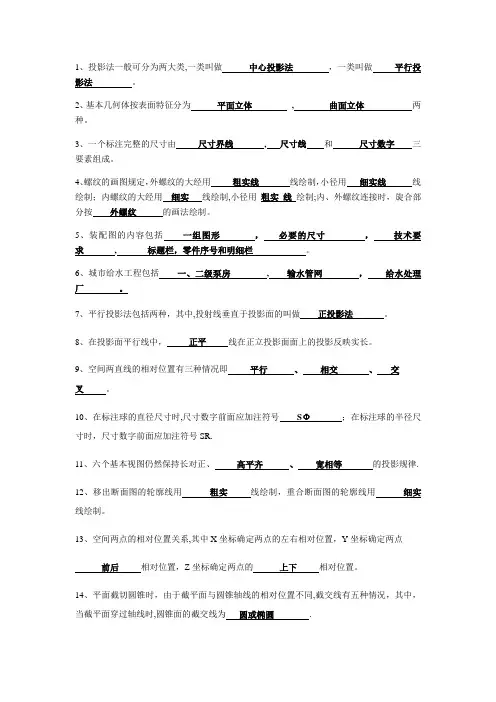
1、投影法一般可分为两大类,一类叫做中心投影法,一类叫做平行投影法。
2、基本几何体按表面特征分为平面立体, 曲面立体两种。
3、一个标注完整的尺寸由尺寸界线, 尺寸线和尺寸数字三要素组成。
4、螺纹的画图规定,外螺纹的大经用粗实线线绘制,小径用细实线线绘制;内螺纹的大经用细实线绘制,小径用粗实线绘制;内、外螺纹连接时,旋合部分按外螺纹的画法绘制。
5、装配图的内容包括一组图形,必要的尺寸,技术要求, 标题栏,零件序号和明细栏。
6、城市给水工程包括一、二级泵房, 输水管网,给水处理厂。
7、平行投影法包括两种,其中,投射线垂直于投影面的叫做正投影法。
8、在投影面平行线中,正平线在正立投影面面上的投影反映实长。
9、空间两直线的相对位置有三种情况即平行、相交、交叉。
10、在标注球的直径尺寸时,尺寸数字前面应加注符号SΦ;在标注球的半径尺寸时,尺寸数字前面应加注符号SR.11、六个基本视图仍然保持长对正、高平齐、宽相等的投影规律.12、移出断面图的轮廓线用粗实线绘制,重合断面图的轮廓线用细实线绘制。
13、空间两点的相对位置关系,其中X坐标确定两点的左右相对位置,Y坐标确定两点前后相对位置,Z坐标确定两点的上下相对位置。
14、平面截切圆锥时,由于截平面与圆锥轴线的相对位置不同,截交线有五种情况,其中,当截平面穿过轴线时,圆锥面的截交线为圆或椭圆.15、在各种机件的表达方法中,视图包括四种,分别为基本视图、向视图、局部视图和斜视图。
16、国标规定,一个完整的尺寸一般由数字、尺寸线、箭头和尺寸界线组成。
17、在标注球的直径尺寸时,尺寸数字前面应加注符号SΦ;在标注球的半径尺寸时,尺寸数字前面应加注符号SR。
18、三视图的投影规律是:主、俯视图长对正;主、左视图高平齐;俯、左视图宽相等。
19、普通螺纹的旋合长度规定了短旋合长度组S 、中等旋合长度组N 、长旋合长度组L 旋合三种.20、根据断面图布置位置的不用,断面图分为重合断面图和移出断面图。

工程制图知到章节测试答案智慧树2023年最新兰州石化职业技术大学绪论单元测试1.图样是工程师按照自己的想法表达工程对象,并有必要的技术说明的图。
()参考答案:错2.作为工程技术人员,必须学会并掌握工程界通用的技术语言(图样),具备绘制和识读工程图样的能力。
()参考答案:对3.本课程首先要求学习者学会正确使用绘图工具和仪器的方法,按照正确的方法和步骤绘图。
()参考答案:对4.本课程主要是学习如何用二维平面图形来表达三维空间物体,以及由二维平面图形想象出三维空间物体的结构形状。
()参考答案:对5.本课程的教学目标是以识图为主,因此学习者只要学会读图即可,不用进行绘图练习。
()参考答案:错第一章测试1.在同一图样中,字母和数字可以写成A型或者B型,还可以写成直体或者斜体。
()参考答案:错2.在机械图样中,图线有粗细两种线宽,它们之间的比例为2:1。
()参考答案:对3.在机械图样中,用细点画线绘制对称中心线,任何情况下都可以用细实线代替细点画线。
()参考答案:错4.在机械图样中,用细虚线绘制不可见轮廓线,当细虚线是粗实线的延长线时,连接处应留有空隙。
()参考答案:对5.在机械图样中,汉字应写成宋体。
()参考答案:错6.为了更清楚地表达机件的大小,可以在不同的视图上标注机件的同一个尺寸。
()参考答案:错7.在机械图样中,尺寸线可以用细实线单独绘制,也可以用其他图线代替。
()参考答案:错8.判断图中尺寸标注的对错。
()参考答案:错9.当圆弧的半径过大,不需要标注出其圆心位置,可按上图所示的形式标注。
()参考答案:对10.判断如图所示标注的半径尺寸是否正确。
()参考答案:对第二章测试1.上图表示()投影法参考答案:中心2.图中主视图中尺寸20,反映物体的()参考答案:高度3.如图所示,右面的三视图正确地表达左边的形体。
()参考答案:错4.图中P平面是一般位置平面,Q平面是铅垂面。
()参考答案:错5.确定形体中各直线相对投影面的位置。

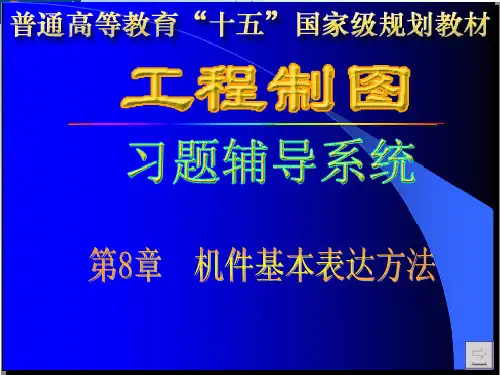

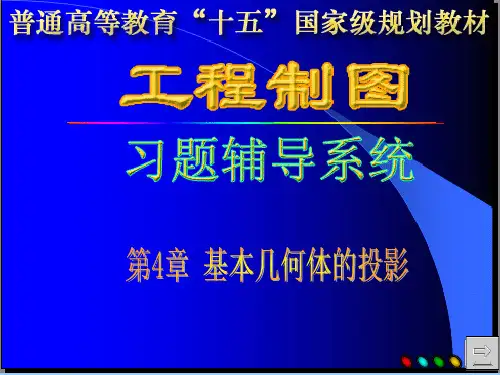
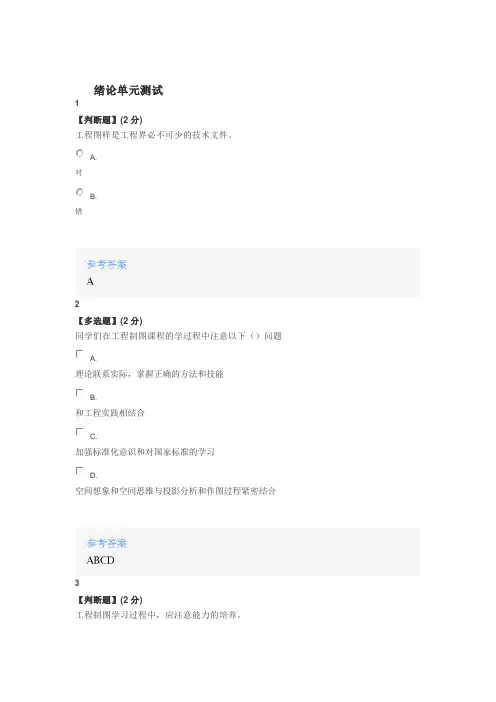
绪论单元测试1【判断题】(2分)工程图样是工程界必不可少的技术文件。
A.对B.错2【多选题】(2分)同学们在工程制图课程的学过程中注意以下()问题A.理论联系实际,掌握正确的方法和技能B.和工程实践相结合C.加强标准化意识和对国家标准的学习D.空间想象和空间思维与投影分析和作图过程紧密结合3【判断题】(2分)工程制图学习过程中,应注意能力的培养。
A.对B.错4【多选题】(2分)工程制图A(1)课程的主要内容为()。
A.表示机件图样的画法B.图示法C.制图基础5【判断题】(2分)工程图样在机械工程中重要的两张图纸是零件图与装配图。
A.对B.错第一章测试1【判断题】(2分)绘制工程图样时所采用的图纸幅面应符合国家标准GB/T14689—2008规定的图纸幅面,A4图纸幅面为“420×297”。
A.错B.对2【单选题】(2分)图中图形与其实物相应要素的线性尺寸之比,称为比例,那么“1:2”是()比例。
A.缩小B.放大C.原值比例3【判断题】(2分)图框是指图纸上限定绘图区域的线框。
在图纸上必须用粗实线画出图框,其格式分为不留装订边和留有装订边两种,但同一产品的图样只能采用同一种格式。
A.错B.对4【判断题】(2分)3.5号字,表示字高为3.5mm。
A.对B.错5【判断题】(2分)绘制工程图样时,优先采粗实线线宽用d=0.5mm或d=0.7mm。
细线的宽度为d/2。
A.对B.错6【判断题】(2分)绘制工程图样时,一般用H或2H的铅笔画底稿,用HB的铅笔写字,用HB或B的铅笔加深图线。
A.对B.错7【判断题】(2分)锥度指正圆锥体底圆直径与锥高之比。
在图样上标注锥度时,以1∶n的形式,并在前面加上锥度符号。
A.对B.错8【多选题】(2分)关于圆弧连接作图,下列叙述正确的是()。
A.圆弧连接的基本形式通常有三种B.圆弧连接作图之一:步骤求连接圆弧的圆心C.圆弧连接作图之二:步骤求连接圆弧的圆心找出连接点即切点的位置D.圆弧连接作图之三:步骤求连接圆弧的圆心在两连接点之间作出连接圆弧。
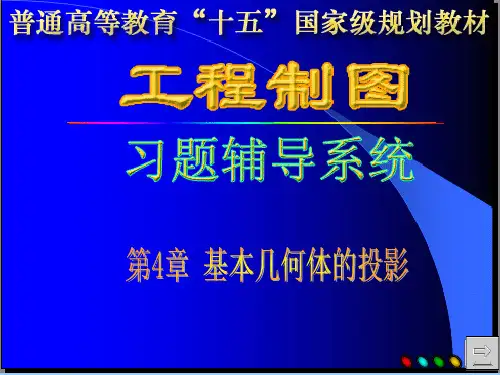
第一章1.(Q1) What is the difference between a host and an end system? List the types of endsystems. Is a Web server an end system?Answer: There is no difference. Throughout this text, the words “host” and “end system” are used interchangeably. End systems include PCs, workstations, Web servers, mail servers, Internet-connected PDAs, WebTVs, etc.2.(Q2) The word protocol is often used to describe diplomatic relations. Give an example of adiplomatic protocol.Answer: Suppose Alice, an ambassador of country A wants to invite Bob, an ambassador of country B, over for dinner. Alice doesn’t simply just call Bob on the phone and say, come to our dinner table now”. Instead, she calls Bob and suggests a date and time. Bob may respond by saying he’s not available that particular date, but he is available another date. Alice and Bob continue to send “messages” back and forth until they agree on a date and time. Bob then shows up at the embassy on the agreed date, hopefully not more than 15 minutes before or after the agreed time. Diplomatic protocols also allow for either Alice or Bob to politely cancel the engagement if they have reasonable excuses.3.(Q3) What is a client program? What is a server program? Does a server program requestand receive services from a client program?Answer: A networking program usually has two programs, each running on a different host, communicating with each other. The program that initiates the communication is the client.Typically, the client program requests and receives services from the server program.4.(Q4) List six access technologies. Classify each one as residential access, company access, ormobile access.Answer:1. Dial-up modem over telephone line: residential; 2. DSL over telephone line: residential or small office; 3. Cable to HFC: residential; 4. 100 Mbps switched Etherent: company; 5. Wireless LAN: mobile; 6. Cellular mobile access (for example, 3G/4G): mobile5.(Q5) List the available residential access technologies in your city. For each type of access,provide the advertised downstream rate, upstream rate, and monthly price.Answer: Current possibilities include: dial-up (up to 56kbps); DSL (up to 1 Mbps upstream, up to 8 Mbps downstream); cable modem (up to 30Mbps downstream, 2 Mbps upstream.6.(Q7) What are some of the physical media that Ethernet can run over?Answer: Ethernet most commonly runs over twisted-pair copper wire and “thin” coaxial cable. It also can run over fibers optic links and thick coaxial cable.7.(Q8) Dial-up modems, HFC, and DSL are all used for residential access. For each of theseaccess technologies, provide a range of transmission rates and comment on whether the transmission rate is shared or dedicated.Answer:Dial up modems: up to 56 Kbps, bandwidth is dedicated; ISDN: up to 128 kbps, bandwidth is dedicated; ADSL: downstream channel is .5-8 Mbps, upstream channel is up to1 Mbps, bandwidth is dedicated; HFC, downstream channel is 10-30 Mbps and upstreamchannel is usually less than a few Mbps, bandwidth is shared.8.(Q13) Why is it said that packet switching employs statistical multiplexing? Contraststatistical multiplexing with the multiplexing that takes place in TDM.Answer: In a packet switched network, the packets from different sources flowing on a link do not follow any fixed, pre-defined pattern. In TDM circuit switching, each host gets the same slot in a revolving TDM frame.9.(Q14) Suppose users share a 2Mbps link. Also suppose each user requires 1Mbps whentransmitting, but each user transmits only 20 percent of the time. (See the discussion of statistical multiplexing in Section 1.3.)a.When circuit switching is used, how many users can be supported?b.For the remainder of this problem, suppose packet switching is used. Why will there beessentially no queuing delay before the link if two or fewer users transmit at the same time? Why will there be a queuing delay if three users transmit at the same time?c.Find the probability that a given user is transmitting.d.Suppose now there are three users. Find the probability that at any given time, allthree users are transmitting simultaneously. Find the fraction of time during which the queue grows.Answer:a. 2 users can be supported because each user requires half of the link bandwidth.b.Since each user requires 1Mbps when transmitting, if two or fewer users transmitsimultaneously, a maximum of 2Mbps will be required. Since the available bandwidth of the shared link is 2Mbps, there will be no queuing delay before the link. Whereas, if three users transmit simultaneously, the bandwidth required will be 3Mbps which is more than the available bandwidth of the shared link. In this case, there will be queuing delay before the link.c.Probability that a given user is transmitting = 0.2d.Probability that all three users are transmitting simultaneously=(33)p3(1−p)0=0.23=0.008. Since the queue grows when all the users are transmitting, the fraction oftime during which the queue grows (which is equal to the probability that all three users are transmitting simultaneously) is 0.008.10.(Q16) Consider sending a packet from a source host to a destination host over a fixed route.List the delay components in the end-to-end delay. Which of these delays are constant and which are variable?Answer:The delay components are processing delays, transmission delays, propagation delays, and queuing delays. All of these delays are fixed, except for the queuing delays, which are variable.11.(Q19) Suppose Host A wants to send a large file to Host B. The path from Host A to Host Bhas three links, of rates R1 = 250 kbps, R2 = 500 kbps, and R3 = 1 Mbps.a.Assuming no other traffic in the network, what is the throughput for the file transfer.b.Suppose the file is 2 million bytes. Roughly, how long will it take to transfer the file toHost B?c.Repeat (a) and (b), but now with R2 reduced to 200 kbps.Answer:a.250 kbpsb.64 secondsc.200 kbps; 80 seconds12.(P2) Consider the circuit-switched network in Figure 1.8. Recall that there are n circuits oneach link.a.What is the maximum number of simultaneous connections that can be in progress atany one time in this network?b.Suppose that all connections are between the switch in the upper-left-hand cornerand the switch in the lower-right-hand corner. What is the maximum number ofsimultaneous connections that can be in progress?Answer:a.We can n connections between each of the four pairs of adjacent switches. This gives amaximum of 4n connections.b.We can n connections passing through the switch in the upper-right-hand corner andanother n connections passing through the switch in the lower-left-hand corner, giving a total of 2n connections.13.(P4) Review the car-caravan analogy in Section 1.4. Assume a propagation speed of 50km/hour.a.Suppose the caravan travels 150 km, beginning in front of one tollbooth, passingthrough a second tollbooth, and finishing just before a third tollbooth. What is theend-to-end delay?b.Repeat (a), now assuming that there are five cars in the caravan instead of ten.Answer: Tollbooths are 150 km apart, and the cars propagate at 50 km/hr, A tollbooth services a car at a rate of one car every 12 seconds.a.There are ten cars. It takes 120 seconds, or two minutes, for the first tollbooth to servicethe 10 cars. Each of these cars has a propagation delay of 180 minutes before arriving at the second tollbooth. Thus, all the cars are lined up before the second tollbooth after 182 minutes. The whole process repeats itself for traveling between the second and third tollbooths. Thus the total delay is 364 minutes.b.Delay between tollbooths is 5*12 seconds plus 180 minutes, i.e., 181minutes. The totaldelay is twice this amount, i.e., 362 minutes.14.(P5) This elementary problem begins to explore propagation delay and transmission delay,two central concepts in data networking. Consider two hosts, A and B, connected by a single link of rate R bps. Suppose that the two hosts are separated by m meters, and suppose the propagation speed along the link is s meters/sec. Host A is to send a packet of size L bits to Host B.a.Express the propagation delay, d prop , in terms of m and s.b.Determine the transmission time of the packet, d trans , in terms of L and R.c.Ignoring processing and queuing delays, obtain an expression for the end-to-enddelay.d.Suppose Host A begins to transmit the packet at time t = 0. At time t = d trans , whereis the last bit of the packet?e.Suppose d prop is greater than d trans . At time t = d trans , where is the first bit of thepacket?f.Suppose d prop is less than d trans . At time t = d trans , where is the first bit of thepacket?g.Suppose s = 2.5*108, L = 100bits, and R = 28kbps. Find the distance m so that d propequals d trans .Answer:a. d prop = m/s seconds.b. d trans = L/R seconds.c. d end-to-end = (m/s + L/R) seconds.d.The bit is just leaving Host A.e.The first bit is in the link and has not reached Host B.f.The first bit has reached Host B.g.Wantm=LRS=10028∗103(2.5∗108)=893 km.15.(P6) In this problem we consider sending real-time voice from Host A to Host B over apacket-switched network (VoIP). Host A converts analog voice to a digital 64 kbps bit stream on the fly. Host A then groups the bits into 56-Byte packets. There is one linkbetween Host A and B; its transmission rate is 500 kbps and its propagation delay is 2 msec.As soon as Host A gathers a packet, it sends it to Host B. As soon as Host B receives an entire packet, it converts the packet’s bits to an analog signal. How much time elapses from the time a bit is created (from the original analog signal at Host A) until the bit is decoded (as part of the analog signal at Host B)?Answer: Consider the first bit in a packet. Before this bit can be transmitted, all of the bits in the packet must be generated. This requires56∗8sec=7 msec64∗103The time required to transmit the packet is56∗8sec=896 μsec500∗103Propagation delay = 2 msec.The delay until decoding is7msec + 896μsec + 2msec = 9.896 msecA similar analysis shows that all bits experience a delay of 9.896 msec.16.(P9) Consider a packet of length L which begins at end system A, travels over one link to apacket switch, and travels from the packet switch over a second link to a destination end system. Let d i, s i, and R i denote the length, propagation speed, and the transmission rate of link i, for i= 1, 2. The packet switch delays each packet by d proc. Assuming no queuing delays, in terms of d i, s i, R i, (i= 1, 2), and L, what is the total end-to-end delay for the packet? Suppose now the packet Length is 1,000 bytes, the propagation speed on both links is 2.5 * 108m/s, the transmission rates of both links is 1 Mbps, the packet switch processing delay is 2 msec, the length of the first link is 6,000 km, and the length of the last link is 3,000 km. For these values, what is the end-to-end delay?Answer: The first end system requires L/R1to transmit the packet onto the first link; the packet propagates over the first link in d1/s1; the packet switch adds a processing delay ofd proc; after receiving the entire packet, the packet switch requires L/R2to transmit the packetonto the second link; the packet propagates over the second link in d2/s2. Adding these five delays givesd end-end = L/R1 + L/R2 + d1/s1 + d2/s2 + d procTo answer the second question, we simply plug the values into the equation to get 8 + 8 +24 + 12 + 2 = 54 msec.17.(P10) In the above problem, suppose R1 = R2 = R and d proc= 0. Further suppose the packetswitch does not store-and-forward packets but instead immediately transmits each bit it receivers before waiting for the packet to arrive. What is the end-to-end delay?Answer: Because bits are immediately transmitted, the packet switch does not introduce any delay; in particular, it does not introduce a transmission delay. Thus,d end-end = L/R + d1/s1 + d2/s2For the values in Problem 9, we get 8 + 24 + 12 = 44 msec.18.(P11) Suppose N packets arrive simultaneously to a link at which no packets are currentlybeing transmitted or queued. Each packet is of length L and the link has transmission rate R.What is the average queuing delay for the N packets?Answer:The queuing delay is 0 for the first transmitted packet, L/R for the second transmitted packet, and generally, (n-1)L/R for the nth transmitted packet. Thus, the average delay for the N packets is(L/R + 2L/R + ....... + (N-1)L/R)/N = L/RN(1 + 2 + ..... + (N-1)) = LN(N-1)/(2RN) = (N-1)L/(2R)Note that here we used the well-known fact that1 +2 + ....... + N = N(N+1)/219.(P14) Consider the queuing delay in a router buffer. Let I denote traffic intensity; that is, I =La/R. Suppose that the queuing delay takes the form IL/R (1-I) for I<1.a.Provide a formula for the total delay, that is, the queuing delay plus the transmissiondelay.b.Plot the total delay as a function of L/R.Answer:a.The transmission delay is L / R . The total delay isILR(1−I)+LR=L/R1−Ib.Let x = L / R.Total delay=x 1−αx20.(P16) Perform a Traceroute between source and destination on the same continent at threedifferent hours of the day.a.Find the average and standard deviation of the round-trip delays at each of the threehours.b.Find the number of routers in the path at each of the three hours. Did the pathschange during any of the hours?c.Try to identify the number of ISP networks that the Traceroute packets pass throughfrom source to destination. Routers with similar names and/or similar IP addresses should be considered as part of the same ISP. In your experiments, do the largest delays occur at the peering interfaces between adjacent ISPs?d.Repeat the above for a source and destination on different continents. Compare theintra-continent and inter-continent results.Answer: Experiments.21.(P18) Suppose two hosts, A and B, are separated by 10,000 kilometers and are connectedby a direct link of R = 2 Mbps. Suppose the propagation speed over the link is 2.5•108 meters/sec.a.Calculate the bandwidth-delay product, R •d prop.b.Consider sending a file of 400,000 bits from Host A to Host B. Suppose the file is sentcontinuously as one large message. What is the maximum number of bits that will be in the link at any given time?c.Provide an interpretation of the bandwidth-delay product.d.What is the width (in meters) of a bit in the link? Is it longer than a football field?e.Derive a general expression for the width of a bit in terms of the propagation speed s,the transmission rate R, and the length of the link m.Answer:a.d prop = 107 / 2.5•108 = 0.04 sec; so R •d prop = 80,000bitsb.80,000bitsc.The bandwidth-delay product of a link is the maximum number of bits that can be in thelink.d. 1 bit is 125 meters long, which is longer than a football fielde.m / (R •d prop ) = m / (R * m / s) = s/R22.(P20) Consider problem P18 but now with a link of R = 1 Gbps.a.Calculate the bandwidth-delay product, R·d prop .b.Consider sending a file of 400,000 bits from Host A to Host B. Suppose the file is sentcontinuously as one big message. What is the maximum number of bits that will be inthe link at any given time?c.What is the width (in meters) of a bit in the link?Answer:a.40,000,000 bits.b.400,000 bits.c.0.25 meters.23.(P21) Refer again to problem P18.a.How long does it take to send the file, assuming it is sent continuously?b.Suppose now the file is broken up into 10 packet is acknowledged by the receiver andthe transmission time of an acknowledgment packet is negligible. Finally, assumethat the sender cannot send a packet until the preceding one is acknowledged. Howlong does it take to send the file?pare the results from (a) and (b).Answer:a. d trans + d prop = 200 msec + 40 msec = 240 msecb.10 * (t trans + 2 t prop ) = 10 * (20 msec + 80 msec) = 1.0 sec。
第1章制图的基本知识和技能第1章制图的基本知识和技能1-2 按照左图的形式,在图形右边空白处重画一次。
第1章制图的基本知识和技能1-3 尺寸标注练习:填注下列图形中的尺寸,尺寸数值按1:1从图上量,取整数。
1-4 分析下列平面图形并标注尺寸。
(尺寸数值按1:1从图中量,取整数)(1)(2)第1章制图的基本知识和技能1-5 尺寸标注改错:圈出错误的尺寸标注,并在右边空白图上正确标注。
1-6 按1:2的比例画下面的图形。
(1)椭圆(2)1:8锥度第1章制图的基本知识和技能1-7 在A4图纸上按1:1比例画出吊钩的平面图形,图名为:几何作图。
第2章投影基础2-1 根据直观图中各点的位置,画出它们的两面投影图。
2-2 已知各点的两面投影,画出它们的第三投影和直观图。
2-3 画出A(10,35,15)、B(20,35,0)、C(30,0,25)三点的三面投影图。
2-4 已知点B在点A的左方35毫米,在点A的前方10毫米,在点A的上方20毫米处;点C与点B同高,且点C的坐标X=Y=Z;点D在点C的正下方26毫米处,试画出各点的三面投影图。
第2章投影基础2-5 已知点A的两面投影,点B在点A的左方20毫米,前方15毫米,上方10毫米处,求线段AB的三面投影。
2-6 已知点A,作正平线AB的三面投影,使AB=20毫米,α=450,(点B在点A的右侧)。
2-7 画出下列各直线的第三投影,并判别直线对投影面的相对位置。
(1)(2)(3)(4)AB是___水平__线CD是__正平__线EF是__侧垂___线GH是_一般位置_线第2章投影基础2-8 根据已知条件完成直线的三面投影。
(1)AB是侧平线,(2)CD是一般位置直线,点C在(3)EF是正垂线,在(4)GH是正平线,长度为距离W面18mm。
V面前方22mm,点D则属于V面。
H面上方20mm处。
25mm, 点H在点G 的下方。
2-9 已知线段AB 的两面投影,求AB 的实长和对W 面的倾角。
绪论单元测试1.图样是工程师按照自己的想法表达工程对象,并有必要的技术说明的图。
()A:错B:对答案:A2.作为工程技术人员,必须学会并掌握工程界通用的技术语言(图样),具备绘制和识读工程图样的能力。
()A:对B:错答案:A3.本课程首先要求学习者学会正确使用绘图工具和仪器的方法,按照正确的方法和步骤绘图。
()A:对B:错答案:A4.本课程主要是学习如何用二维平面图形来表达三维空间物体,以及由二维平面图形想象出三维空间物体的结构形状。
()A:错B:对答案:B5.本课程的教学目标是以识图为主,因此学习者只要学会读图即可,不用进行绘图练习。
()A:错B:对答案:A第一章测试1.在同一图样中,字母和数字可以写成A型或者B型,还可以写成直体或者斜体。
()A:对B:错答案:B2.在机械图样中,图线有粗细两种线宽,它们之间的比例为2:1。
()A:错B:对答案:B3.在机械图样中,用细点画线绘制对称中心线,任何情况下都可以用细实线代替细点画线。
()A:对答案:B4.在机械图样中,用细虚线绘制不可见轮廓线,当细虚线是粗实线的延长线时,连接处应留有空隙。
()A:对B:错答案:A5.在机械图样中,汉字应写成宋体。
()A:对B:错答案:B6.为了更清楚地表达机件的大小,可以在不同的视图上标注机件的同一个尺寸。
()A:错B:对答案:A7.在机械图样中,尺寸线可以用细实线单独绘制,也可以用其他图线代替。
()A:对B:错答案:B8.判断图中尺寸标注的对错。
()A:对B:错答案:B9.当圆弧的半径过大,不需要标注出其圆心位置,可按上图所示的形式标注。
()A:错B:对答案:B10.判断如图所示标注的半径尺寸是否正确。
()A:对B:错答案:A第二章测试1.上图表示()投影法A:正B:斜C:无法判断答案:D2.图中主视图中尺寸20,反映物体的()A:无法确定B:高度C:长度D:宽度答案:B3.如图所示,右面的三视图正确地表达左边的形体。